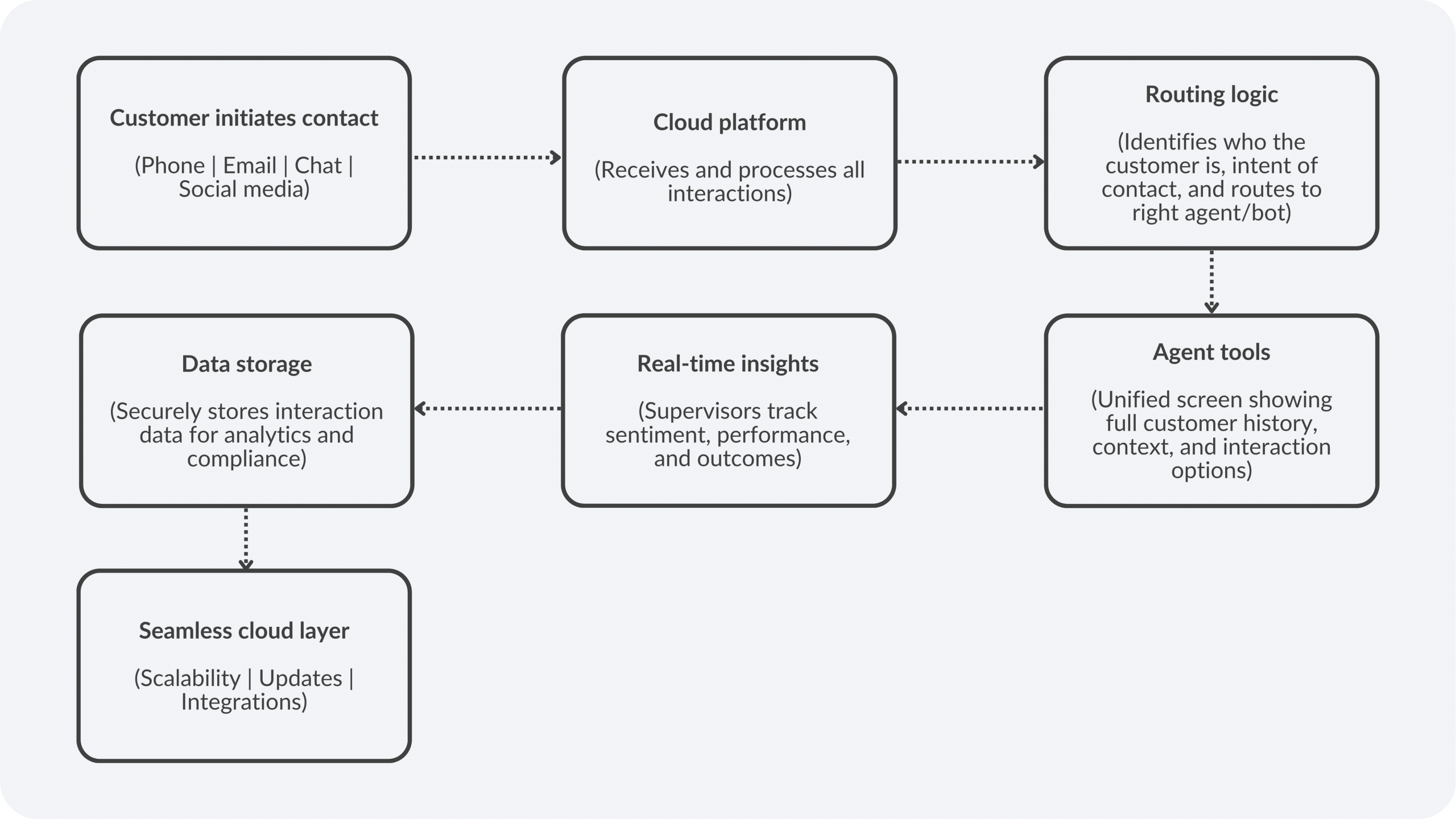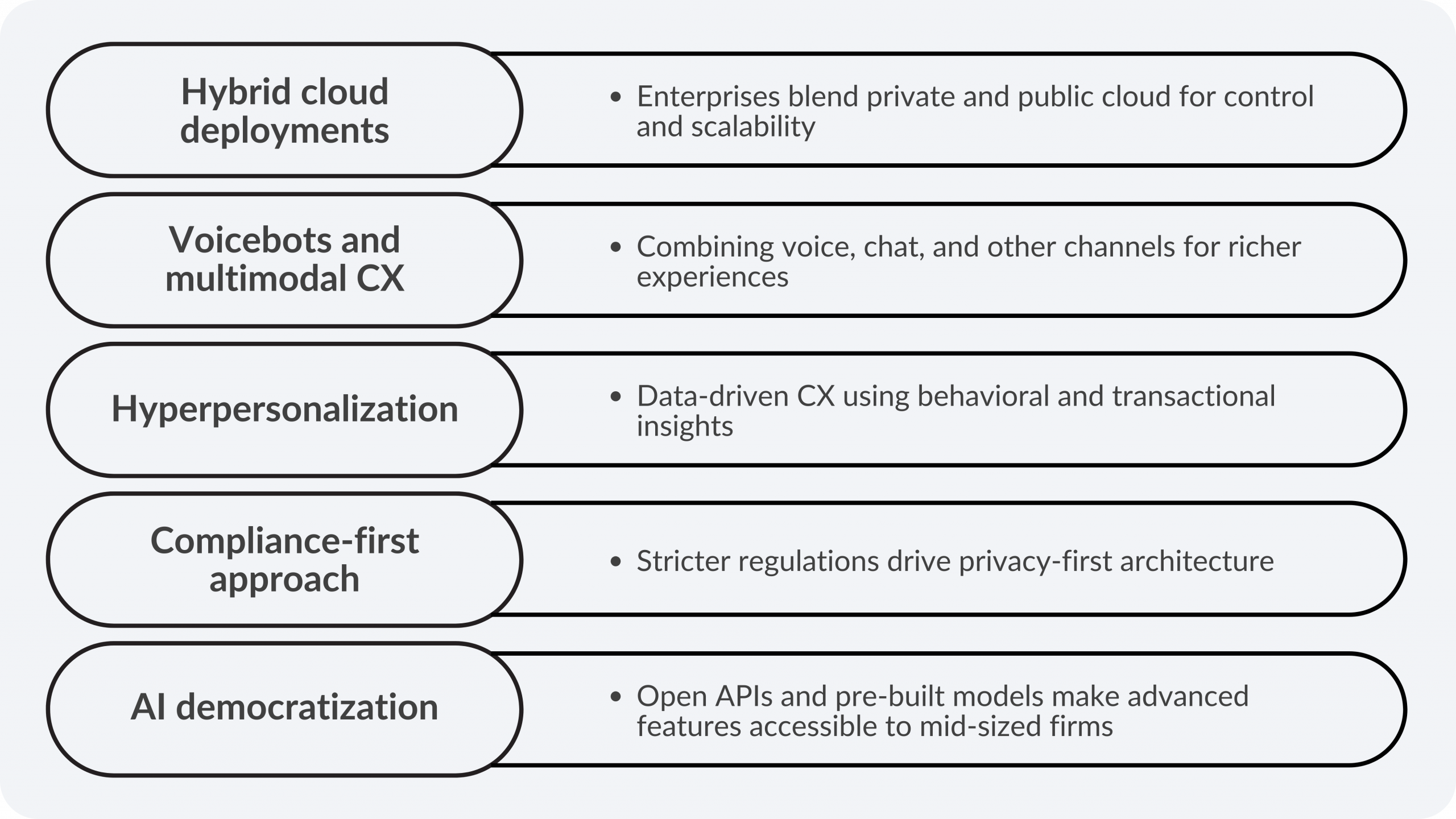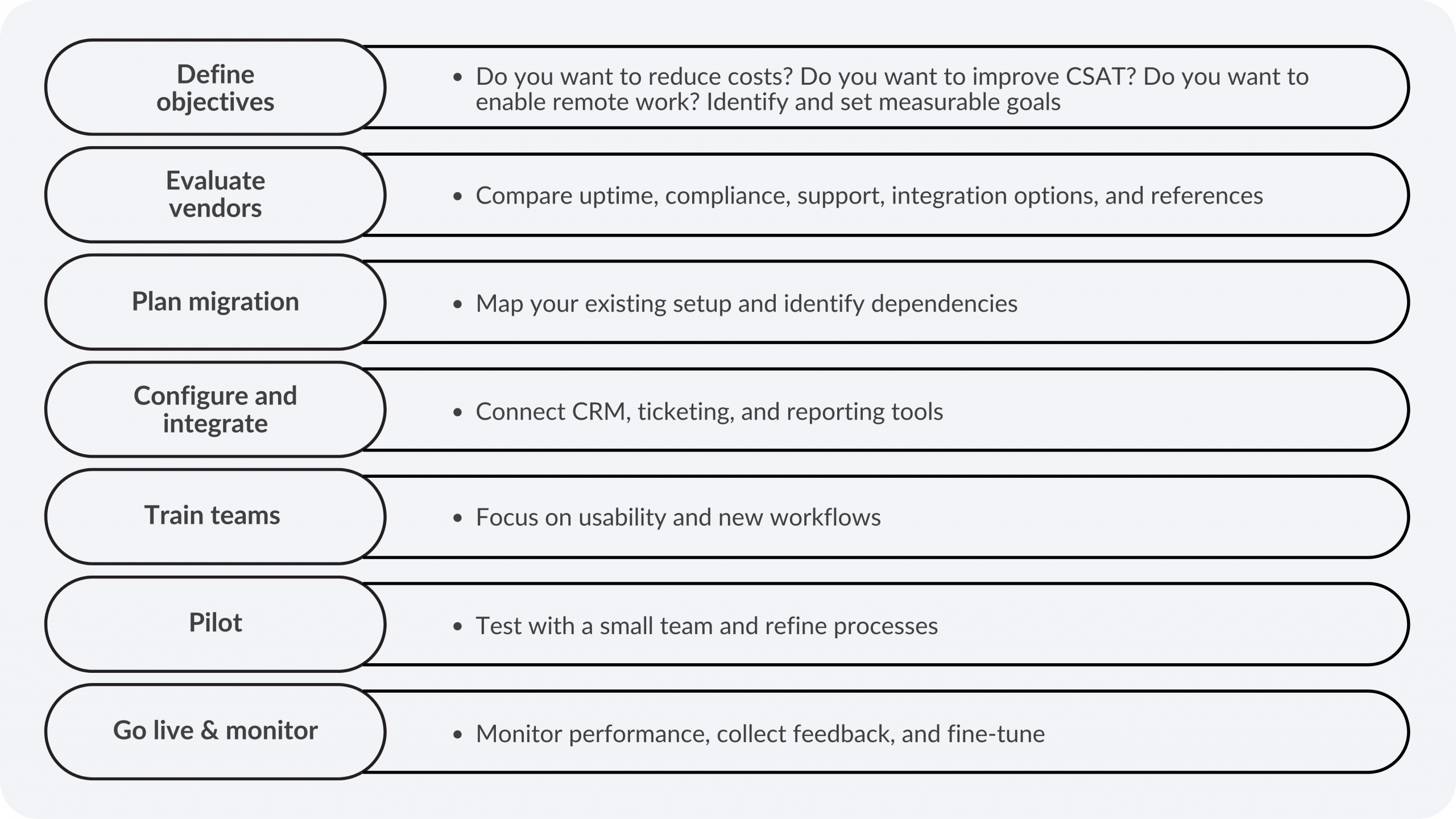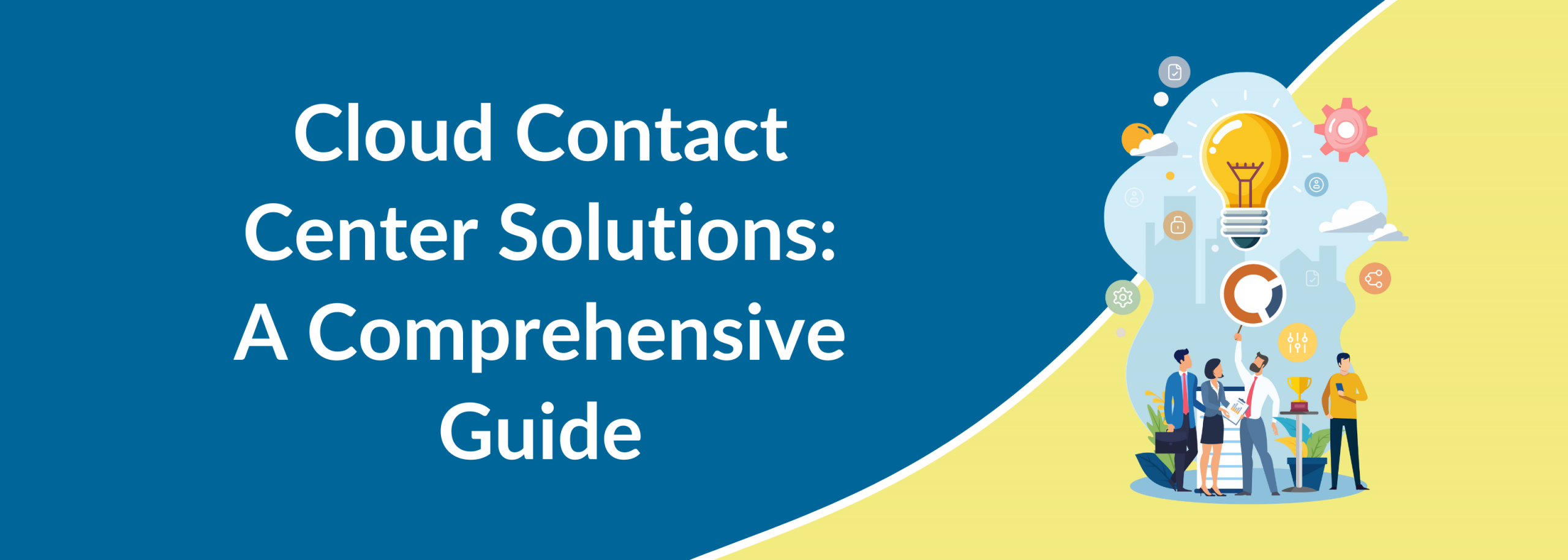Cloud Contact Center: Benefits, Features & Implementation Guide (2025)
A few weeks ago, I read a LinkedIn post that perfectly illustrated how broken customer journeys can ruin even the best marketing efforts.
A brand had launched an impressive ad campaign for ready-to-cook noodles. It had catchy messaging, sharp pricing, and a clear value proposition.
It had everything going for it.
But when a potential customer tried to find the product online, it wasn’t available on quick-commerce sites.
The website was difficult to locate, and when she finally found it, the price was higher than advertised.
She dropped off right there.
What does this anecdote tell you?
Great marketing is useless if you can’t deliver a consistent, connected experience across all touchpoints.
Customers today converse across channels, from social media to the web to chat to calls, and they expect the same level of context and continuity everywhere.
This is where cloud contact centers come in handy.
A Cloud contact center solution platform make it easy to bring together omnichannel communication, real-time insights, and AI-driven intelligence. This creates a unified experience across the entire customer journey, from awareness to loyalty.
What Is a Cloud Contact Center?
A cloud contact center operates on a subscription-based model, where all hardware, software, and infrastructure are hosted and managed by a third-party provider. In most cases, you only pay for what you use.
You don’t have to make any upfront investments in hardware and infrastructure. Besides, you don’t need skilled people to ensure maintenance and updates of your software and hardware infrastructure.
With cloud, you can focus on your core business objectives of growing and sustaining your business, while your contact center infrastructure is handled by your service provider
All you need is a working Internet connection, access to a browser, and a pair of headphones to access cloud contact centers. This is very helpful, especially when you are working in a remote or hybrid environment, as you can connect from anywhere and at any time.
Cloud creates a level playing field for contact centers, regardless of size, and can help them enhance the customer experience. You get to have all enterprise-grade features for a subscription fee.
What Are the Attributes of a Cloud Contact Center?
Some of the attributes you should keep in mind include:
- Can you administer your cloud contact center platform as if you were on-premises?
- Does it support true multi-tenancy?
- Is your cloud offering built as-a-service, allowing you to administer, tenantize easily, and segment data
- Does your provider handle the maintenance and security of your servers at the data centers?
- You don’t need to sign a massive contract with the vendor for the number of seats or contract duration. You don’t have to provide any minimum commitments.
How Does a Cloud Contact Center Work?
Cloud contact centers connect customers and agents through internet-based communication channels.
Here’s a simple flow

On-Premise vs. Cloud Contact Centers: Key Differences
| Aspect | On-Premise Contact Center | Cloud Contact Center |
| Infrastructure ownership | You own, host, and maintain all the hardware and software infrastructure in-house. | Your service provider manages and maintains the entire infrastructure on secure cloud servers. |
| Scalability & flexibility | You need to make a huge capital investment when you want to expand capacity or add new features. Besides, you need to look at long lead times. | Adding and removing agents, channels, features, or locations can be done with a few clicks. |
| Cost structure | You need to make heavy upfront capital expenses for hardware, licenses, and ongoing maintenance. | You are looking at predictable monthly costs on a subscription or pay-as-you-go model. |
| Maintenance & updates | You need to staff your IT teams with skills to handle regular system maintenance, patches, and upgrades. | Maintenance, updates, and security of your infrastructure are a part of the service-level agreement (SLA). |
| Accessibility & mobility | Your agents must either be physically present in your office or connect via expensive VPNs to access your contact center platform. | Your agents can log in securely from anywhere with Internet access on any device. |
| Global reach | You need additional hardware and infrastructure when you expand your operations into new regions, which can be cost-prohibitive. | It doesn’t matter where you want to expand or how many seats you want to add; you can do that with a click of a button. Your cloud contact platform can work seamlessly across locations. |
| Disaster recovery & continuity | You need to have backup fallback servers, failover routers, and Internet connectivity to ensure continuity and disaster recovery. | Your cloud solutions come pre-built with disaster recovery, automated backups, and high availability, ensuring minimal downtime. |
| Environmental impact | Your dedicated infrastructure will consume significant energy and resources. | Your cloud infrastructure is a sustainable option as it is shared between organizations. This reduces energy consumption and carbon footprint. |
| Regulatory compliance | You will need to independently implement and monitor compliance with policies such as GDPR or PCI DSS. | Most cloud solution providers are pre-certified for major compliance frameworks, making it easier for you to meet your regulatory needs. |
| Customer experience | Your customer preferences and expectations keep changing. With on-premise, you have a limited ability to adapt quickly. | Your ability to adapt to changing customer preferences and expectations is exponentially higher, as cloud enables seamless, personalized, and omnichannel interactions. |
| Agent experience | Your agents are constrained by outdated interfaces and manual workflows that reduce efficiency and morale. | Your cloud solutions offer intuitive dashboards, modern UIs, and real-time support tools that enhance productivity and satisfaction. |
How Do Businesses Benefit from a Cloud-Based Contact Center?
Improved Accessibility
How do you access your cloud contact center?
You only need an internet connection and a browser to use the platform.
That’s it.
Besides, it offers omnichannel experience, allowing agents to see a single view of your customers regardless of the channel or interface used for the interaction.
How about integrations with best-of-breed IT systems?
Cloud platforms typically have open APIs, using which you can integrate with any IT system. Moreover, most cloud platforms have pre-built integrations with multiple CRMs, ERPs, and helpdesk systems.
This allows customers to reach you on the channel they prefer, and agents deliver smoother, more contextual conversations every single time.
Personalized Experiences
With cloud platforms, you have access to every customer interaction across all channels and interfaces. This gives you a wealth of insights into customer behavior and their needs, wants, and desires.
Let us look at an example.
A customer browses your airline-branded credit card on a mobile app and later lands on your website.
Because your systems are connected, the site can highlight that same credit card and its perks, making the experience feel personalized and relevant.
What if the customer doesn’t take action?
You can nudge the customer by offering a special deal next time, such as waiving the annual fee for a limited period.
This not only enhances engagement but also encourages customers to take action.
Low Entry Barrier
Have you always worried about hefty hardware investments and long-term commitments while setting up a contact center?
This is no longer the case with cloud contact centers.
You pay-as-you-go with cloud, and you get to have enterprise-grade capabilities right from day one, making it a level playing field for you to compete.
You don’t have to subscribe to the entire cloud offering as well. You can choose the channels you want, integrate your internal systems, and gain a unified customer view at a pay-as-you-go pricing.
Quick Scalability
Do you need to add more agents during peak season? Or scale down once things quieten?
With a cloud contact center, you can do that instantly, literally at the click of a button.
You can also scale specific functionalities as needed.
It is very simple to add functionality such as voice analytics to a single campaign or enable call recording for a specific department with a single click.
Get insights on how a top Indian bank transitioned 1,000+ agents to WFH in 48 hours.
Just switch it on, and you pay for that service for the duration of your usage.
Rapid Implementation
Setting up an on-premises contact center can take 45 to 180 days.
In contrast, a cloud contact center can be deployed and fully operational in as little as 48 hours.
That’s exactly what many organizations did during the pandemic. We moved more than 20,000 seats within two days during the pandemic to enable remote work.
Cost Savings
With cloud contact centers, you don’t need dedicated IT teams for infrastructure maintenance, nor do you need to pay hefty software licensing or hardware fees.
Your service provider handles everything from updates to uptime management as part of the service.
You get to have predictable monthly costs and significant long-term savings.
Read our blog on: On-Premise vs Cloud Contact Centers Guide
Key Features – Cloud Contact Center
Based on my experience deploying cloud contact centers for thousands of customers, I have identified six key features that can make or break your cloud contact center.
1. Omnichannel Support
- How would your website visitors like it if they could instantly speak to a product expert while browsing?
- How would your visitors like it if your chatbot could seamlessly hand off a conversation to a live agent, including the context?
- What if your customers could add products to their online cart and later pick them up from your physical store seamlessly?
That’s the power of omnichannel support, where every touchpoint is tightly integrated effortlessly.
Customers experience your brand as a continuous journey, not a series of disconnected interactions, regardless of whether they interact in-store, online, on social media, via chat, or over the phone.
Your agents get a single view of all your customer interactions through a single interface, empowering them to resolve issues faster and offer more personalized service.
Read our blog on: 4 step omnichannel implementation guide
2. Real-Time Analytics
Every customer interaction is good for your business. It doesn’t matter whether your customers are complaining or offering suggestions and feedback; it is a huge source of data that provides insights to improve your customer experience.
The real question here is whether you are acting on it in real time.
Consider the following scenario.
Your contact center notices a surge in calls and customer complaints. Your analytics digs through the conversations and flags them as delivery-related complaints. Now you can coordinate with your logistics team to avert the crisis before it spirals out of control.
It can also flag misselling, compliance issues, call-handling efficiency, and overall customer satisfaction levels.
You can intervene to see whether this requires additional training or tweaks to the process.
3. Intelligent Routing
Picture that I have a technical question on how to set up the software I got from you. I have filed a complaint via email, and I have been given a ticket number.
But I want this to be fixed sooner than the SLA says it will be.
So, I call your customer support number.
What does your IVR system do?
It knows probably what I want based on my email interaction, and it smartly sends me to a product expert who helps me set it up.
This results in faster resolutions and happier customers.
4. Strong Integrations
To give your customers the best possible experience, your contact center platform must integrate with other systems, such as CRM, helpdesk, and ERP, as well as top-of-the-line systems.
This will allow them to access all customer interactions in a single interface.
Before choosing a solution, ask your provider the following questions:
- Do they offer prebuilt integrations with popular CRMs and helpdesk software?
- Do they support open APIs, and have they integrated with other systems using them?
5. Compliance and Security
You have to ensure the compliance and security of your contact center infrastructure.
Different industries demand different compliance specifications. For instance, healthcare needs HIPAA compliance, payments need PCI-DSS compliance, and collections need FDCPA and Reg-F.
Additionally, you must ensure compliance with regional requirements, such as DoT and TRAI regulations.
So, ask your provider and confirm if they are compliant with global standards and regulations.
It is good to choose a platform that complies with GDPR, HIPAA, PCI-DSS, FDCPA, Reg-F, TCPA, CCPA, FedRamp, DoT, TRAI, and ISAE 3402 Type II.
Also, check whether your provider operates a 24×7 security operations center staffed by dedicated professionals who monitor threats in real time.
A few other things that you need to check include whether your provider offers redundant infrastructure, data encryption, failover routing, and virtualization.
6. Scalability
Business demands keep changing. Your contact center should adapt just as quickly.
With a scalable cloud platform, you can adjust agent capacity on the fly. Do you need to double your team during a busy season or scale back during lean periods? You can do it instantly, without complex technical setups or vendor dependencies.
How about scaling functionality?
That’s part of the deal with cloud platforms as well.
- Do you want to enable voice analytics for a specific campaign?
- Do you want to add business intelligence dashboards for a specific customer temporarily?
- Do you want to use voice bots for a collections campaign?
With cloud platforms, you can do this effortlessly.
Top Features to Look for in 2025 & Beyond
Generative AI Assistance
Do you recall the days when agents had to take notes after every call manually? Or type out the same templated follow-up emails a dozen times a day?
That’s history now.
With Generative AI, contact centers can automatically summarize entire conversations, suggest contextually relevant replies, and even coach agents on tone and empathy while they’re still on the call.
Read our blog on : 10 Applications of Generative AI in Customer Service
Sentiment and Emotion Detection
Every customer call carries emotions, like anger, relief, bewilderment, or delight.
Using speech analytics, modern cloud platforms can now detect these emotional signs in real time and alert supervisors when a call is going off track.
For example, if an agent’s tone becomes defensive or the client’s speech indicates they are angry, the system might provide live coaching recommendations or escalate the situation.
Predictive Workforce Management
How do you staff your contact center?
It is no longer a guessing game.
AI now considers past call volumes, seasonal trends, and planned campaigns to determine how many agents you’ll need.
AI in workforce scheduling adjusts schedules when Mondays yield many billing questions or holiday weekends result in many returns. That means fewer missed calls, reduced stress for agents, and happier customers.
Proactive Customer Experience
Why wait for customers to complain when you can fix problems before they occur?
Proactive CX tools keep an eye on service patterns, transaction data, and customer behavior to find problems before they get worse.
For instance, if there is a delay in shipping, the system can automatically send a message to let customers know before they even contact you.
It’s the kind of anticipation that turns a regular service into a memorable one. Customers love it when a business is a step ahead.
Native WhatsApp and Instagram Support
Businesses are talking to customers on social media and messaging apps at an unprecedented rate.
Cloud contact centers now have native integration with WhatsApp, Instagram, and other messaging apps, so your customer support can talk to customers where they already spend their time.
Think about how easy it would be to solve a problem over WhatsApp while sending a payment link or letting a customer see where their package is using Instagram DMs.
That’s how conversational commerce works.
Security-First Architecture
As more data moves through the cloud, security can’t be an afterthought.
The next generation of platforms is developed with security-first design principles and includes built-in compliance templates for GDPR, TCPA, PCI-DSS, and other standards.
The platform includes data encryption, role-based access, real-time threat detection, and regular audits. This keeps customers’ trust and maintains operations in line with the law.
Explore our detailed blog on : Cloud Contact Center Market 2025: Trends & Stats
Cloud Contact Center Market Trends and Future Outlook
Organizations, by and large, are shifting from reacting to customer needs to anticipating them.
Here’s how the market is shaping for the future.

Cloud Contact Center Implementation Guide

Industry Use Cases – Cloud Contact Center
Here is a brief list of use cases across different industries.
BFSI (Banking, Financial Services & Insurance)
BFIS comes with high volumes and high risk.
Fraud events, card blocks, KYC, and loan servicing demands push BFSI to the cloud for resilience and elastic scaling.
Several market reports indicate that the BFSI sector is the largest end-use segment, driven by stringent compliance requirements and AI-driven fraud and service use cases.
Look at this example.
A bank experiences a surge from a normal 2,000 concurrent calls to 15,000 after a mass card-compromise alert.
Cloud elasticity means they can handle a lot of calls in a short amount of time —not weeks —and send calls that are more likely to be fraudulent to dedicated fraud teams.
E-Commerce & Retail
Order status, returns, delivery ETA, and promotions are all digital-first experiences that nonetheless go up to people when deliveries fail, refunds are split, or loyalty-tier conflicts arise.
Cloud helps connect channels with inventory and order systems almost in real time.
Healthcare
Appointments, pre-authorization, claims, and discharge follow-ups are the standard items in healthcare.
Privacy and audit trails matter.
When combined with smart scheduling, AI-driven voicebots that remind people of appointments significantly reduce no-show rates.
The cloud contact center infrastructure makes it easy for all of them to work together.
Telecom/ISPs
Plan changes are digital, but outages and relocations often escalate.
Cloud enables service providers to seamlessly blend proactive messaging with callback options during spikes.
Public Sector & Utilities
Massive event-driven bursts (storms, policy rollouts).
Cloud offers the resiliency and geo-redundancy needed to stay available when it counts most.
Conclusion
Cloud contact centers are no longer about technology upgrades; they are business enablers.
The organizations that succeed in this environment aren’t the ones with the fanciest dashboards; they’re the ones that use data and AI responsibly, understand the customer story, and empower their teams to act on it.
Cloud has transformed contact centers from call management to conversation orchestration. It is doing it at scale while ensuring security and intelligence.
The future is all about businesses that use cloud and AI with purpose.
